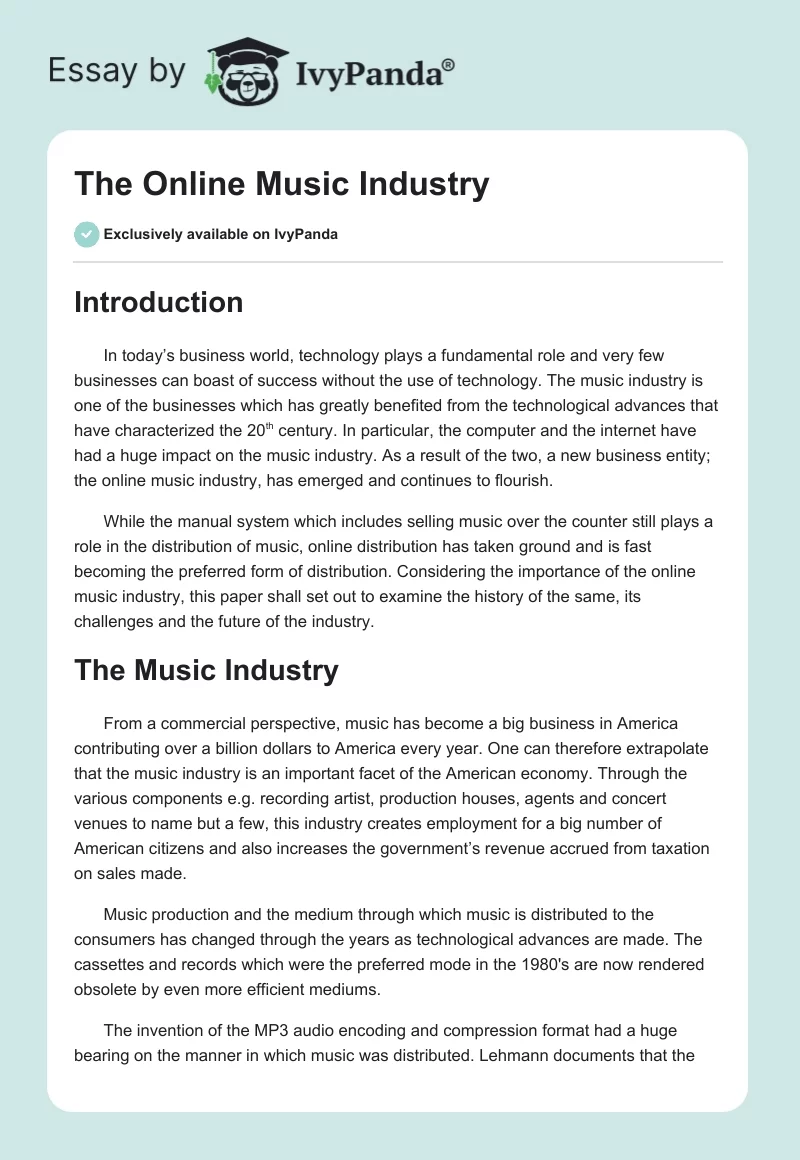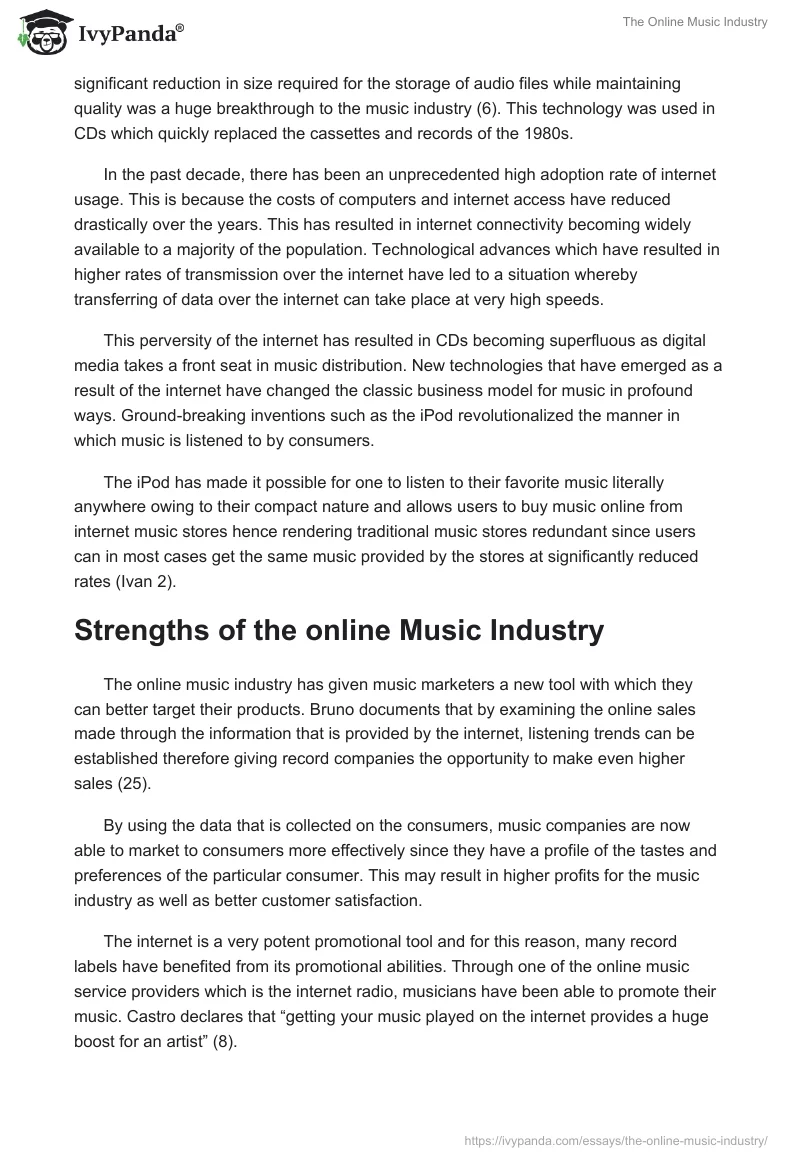Introduction
In today’s business world, technology plays a fundamental role and very few businesses can boast of success without the use of technology. The music industry is one of the businesses which has greatly benefited from the technological advances that have characterized the 20th century. In particular, the computer and the internet have had a huge impact on the music industry. As a result of the two, a new business entity; the online music industry, has emerged and continues to flourish.
While the manual system which includes selling music over the counter still plays a role in the distribution of music, online distribution has taken ground and is fast becoming the preferred form of distribution. Considering the importance of the online music industry, this paper shall set out to examine the history of the same, its challenges and the future of the industry.
The Music Industry
From a commercial perspective, music has become a big business in America contributing over a billion dollars to America every year. One can therefore extrapolate that the music industry is an important facet of the American economy. Through the various components e.g. recording artist, production houses, agents and concert venues to name but a few, this industry creates employment for a big number of American citizens and also increases the government’s revenue accrued from taxation on sales made.
Music production and the medium through which music is distributed to the consumers has changed through the years as technological advances are made. The cassettes and records which were the preferred mode in the 1980’s are now rendered obsolete by even more efficient mediums.
The invention of the MP3 audio encoding and compression format had a huge bearing on the manner in which music was distributed. Lehmann documents that the significant reduction in size required for the storage of audio files while maintaining quality was a huge breakthrough to the music industry (6). This technology was used in CDs which quickly replaced the cassettes and records of the 1980s.
In the past decade, there has been an unprecedented high adoption rate of internet usage. This is because the costs of computers and internet access have reduced drastically over the years. This has resulted in internet connectivity becoming widely available to a majority of the population. Technological advances which have resulted in higher rates of transmission over the internet have led to a situation whereby transferring of data over the internet can take place at very high speeds.
This perversity of the internet has resulted in CDs becoming superfluous as digital media takes a front seat in music distribution. New technologies that have emerged as a result of the internet have changed the classic business model for music in profound ways. Ground-breaking inventions such as the iPod revolutionalized the manner in which music is listened to by consumers.
The iPod has made it possible for one to listen to their favorite music literally anywhere owing to their compact nature and allows users to buy music online from internet music stores hence rendering traditional music stores redundant since users can in most cases get the same music provided by the stores at significantly reduced rates (Ivan 2).
Strengths of the online Music Industry
The online music industry has given music marketers a new tool with which they can better target their products. Bruno documents that by examining the online sales made through the information that is provided by the internet, listening trends can be established therefore giving record companies the opportunity to make even higher sales (25).
By using the data that is collected on the consumers, music companies are now able to market to consumers more effectively since they have a profile of the tastes and preferences of the particular consumer. This may result in higher profits for the music industry as well as better customer satisfaction.
The internet is a very potent promotional tool and for this reason, many record labels have benefited from its promotional abilities. Through one of the online music service providers which is the internet radio, musicians have been able to promote their music. Castro declares that “getting your music played on the internet provides a huge boost for an artist” (8).
This is so because high visibility results in the artist gaining a wider audience therefore giving them a chance to more effectively market their music. As such, the internet creates more value for the copyright holders who are mostly the music label companies. This results in higher profits for the players in the industry.
An increase in sales is one of the primary goals for any business and the music industry is no exception. The internet can assist in the increase in sales by a number of ways. Castro states that internet radio helps increase music sales by providing the listeners with links to online stores where they can buy their favorite music (8).
Also, by playing music by a particular artist, the profile of the artist increases which is goof for marketing and branding purposes. Another means through which the sales have been increased is through the iPod which assists users legally download millions of songs from the internet.
Burkart and McCourt theorize that the online music industry may result in the reduction in the role played by record labels in the music industry (7). Before the advent of online music, artists greatly relied on their record labels to market their music and increase their popularity.
Without the online music industry, most artists were force to transfer the complete copyright of their songs to the record label or the producers therefore reducing their profits. The internet provides a cheap way through which an artist can popularize his/her work and therefore gain popularity without the record label.
Challenges
Arguably the biggest threat that the online music industry faces is that of piracy. The Business Software Alliance defines software piracy as the “unauthorized copying or distribution of copyrighted music”. Despite pirating constituting copyright infringement and therefore being an illegal action punishable by law, it has over the last decade become so prevalent in modern society that most people engage in it without hesitation.
While a country may impose strict copyright laws within its borders, there is no guarantee that the same will be obeyed in other countries which is what makes piracy so hard to curb. The BBC documented that a website which was offering illegal MP3 tracks for sale could not have any legal action taken against it since it was operating in Russian and the Russian laws did not cover digital media therefore making it ok to pirate from the country. Such discrepancies in law are detrimental to the online music industry.
Piracy not only denies the players in the music industry off their rightfully earned pay but it also translates to a slowing in the growth of the music industry as the much needed revenue is siphoned off by pirates
The Future of Online Music
The future of music lies with the emerging technology and at the moment, the leading technology is the internet. As has been noted in this paper, while the online music industry holds a lot of promise, its challenges threaten to reduce the income of the music industry substantially. The major challenge posed is that of piracy through illegal downloads. If piracy is to continue unabated, it will dry up the income of artists and with this, there will no longer be an incentive for musicians to keep on coming up with new music.
Solutions to this must therefore be sought if the online music industry is to remain profitable. To curb the threat that piracy brought about to the music industry, Castro reveals that major record labels are beginning to license their music to online services (8). These services such as Imeem give listeners an opportunity to listen to music online legally for a minimal fee thus discouraging them from participating in piracy.
While there has been a significant growth in digital music sales as a result of new strategies adopted by key players in the industry to tackle the copyright infringement issues, this sales still fail to compensate the losses that the industry faces. Castro suggests that the creation of a nationwide database of sound recordings would enable the copyright holders to gauge the popularity of their songs therefore enabling them to set competitive market rates resulting in higher sales (9).
Conclusion
Online music is potentially big business for all the players in the music industry. This paper set out to examine the growth of online music, its relative benefits and the challenges that it posses in the music industry.
From this paper, it is clear that while online music can give a competitive advantage to the music industry players who take advantage of it therefore allowing them to thrive, it can also result in huge losses and even threaten to collapse the music industry. These problems must be dealt with to ensure the long-term survival of the music industry.
Works Cited
BBC. ‘Legal okay’ for Russian MP3 site. 2005. Web.
Bruno, Antony. Companies are now fighting for data as well as dollars. Billboard, Vol. 121, No. 20. 2009.
Burkart, Patrick and McCourt, Tom. Digital music wars: ownership and control of the celestial jukebox. Rowman & Littlefield, 2006. Print.
Castro, Daniel. “Internet Radio and Copyright Royalties: Reforming a Broken System.” The Information Technology & Innovation Foundation, 2007.
Ivan, Gregor, How the iPod has Changed the Way we Listen to Music. 2007. Web.
Lehmann, Volker. Copyright in the Music Industry. 2005. Web.


